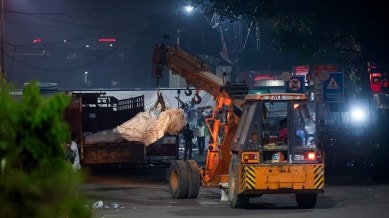Stay updated with the latest - Click here to follow us on Instagram
In Red Fort blast case, DNA samples of Dr Umar’s mother taken: How genetic analysis can establish identity
Matching the DNA with the unidentified bodies at Lok Nayak Hospital can confirm if the suspect died in the explosion or remains at large.

Samples of the DNA of the mother of Dr Umar Nabi Bhat, the man suspected to have been driving the Hyundai i20 that blew up outside Red Fort on Monday, will be matched with samples from the unidentified bodies that were brought to Lok Nayak Hospital from the site of the explosion, official sources said.
Investigators rely on DNA profiling to identify suspects or victims when bodies are physically unrecognisable. Matching the DNA of Dr Umar’s mother against that of the unidentified bodies could confirm whether the suspect was killed in the blast or remains at large.
Umar, a resident of Koil village in Pulwama, was employed at the School of Medical Sciences and Research Centre at Al Falah University in Dhauj, Faridabad.
Why is a mother’s DNA a crucial piece of evidence?
Forensic experts told The Indian Express that DNA testing is the most reliable tool for identification in the aftermath of blasts, fires, or mass disasters in which victims are severely burned or unrecognisable.
Where fingerprinting or facial recognition are not possible, forensic scientists turn to the most preserved parts of the body — typically bones or teeth — to extract DNA. These hard tissues protect genetic material better than soft tissue, even under extreme heat.
Identification is done through kinship analysis, a process that compares the victim’s DNA with that of biological relatives. The DNA of the biological mother, obtained through a simple cheek swab or blood sample, provides direct and reliable genetic reference.
What methods are used in DNA identification?
There are two main methods. The first is called autosomal short tandem repeats (STR) profiling. The patterns of STR – small, repeating sequences of DNA – are unique to every individual. Since a child inherits half their DNA from each parent, matching 50% of these markers with the mother’s sample can confirm identity with high accuracy.
When nuclear DNA is too badly damaged, scientists rely on mitochondrial DNA (mtDNA) analysis. mtDNA is inherited exclusively from the mother and exists in large numbers within each cell. Although it can only confirm maternal lineage, mtDNA analysis remains a vital tool when other methods fail.
What is the process of STR profiling?
The process begins with the collection of biological material such as blood, saliva, bone, teeth, or tissue. The samples are processed to separate DNA from other cellular components. After extraction, the amount and quality of DNA are checked by a process known as gel electrophoresis and an instrument called nano-drop spectrophotometer.
The next step is polymerase chain reaction (PCR) amplification, in which selected STR regions of the DNA are copied millions of times to make them detectable, even if the amount of original DNA is very small.
After amplification, the DNA fragments are subjected to capillary electrophoresis, a process that separates them based on size, and detects the number of repeats at each STR locus. The result is analyzed using the GeneMapper genotyping software and a DNA profile is generated.
This DNA profile is compared with reference samples taken from known individuals, family members, or personal belongings to confirm identity. Because STR patterns are highly specific, the probability of two unrelated people having the same STR profile is extremely low.
What could be the challenges in the process?
The main challenges include degraded DNA, damaged by heat and chemicals, contamination caused by improper handling or mixing of samples, inadequate amounts of available DNA, and mixed DNA profiles when remains of multiple individuals are found together.